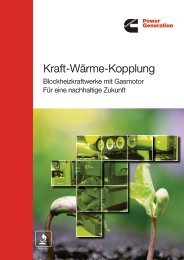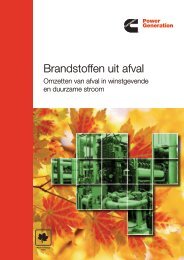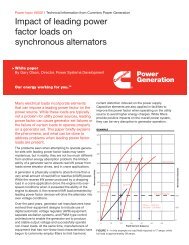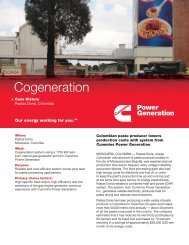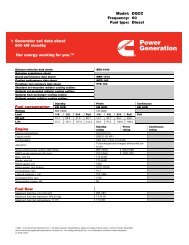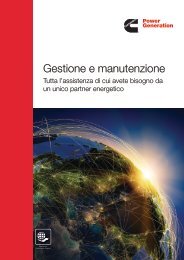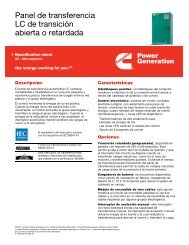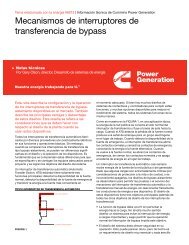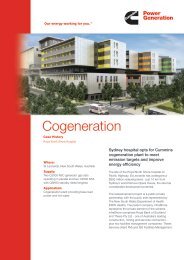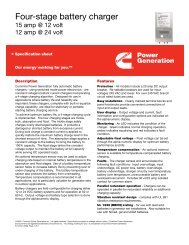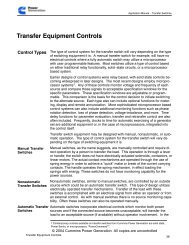appendix
appendix
appendix
You also want an ePaper? Increase the reach of your titles
YUMPU automatically turns print PDFs into web optimized ePapers that Google loves.
APPENDIX G<br />
Application Manual – Liquid Cooled Generator Sets<br />
Phase Angle<br />
Phase angle refers to the relation between two sine waves which do not pass through<br />
zero at the same instant, such as the phases of a three–phase generator. Considering<br />
one full cycle to be 360 degrees, the phase angle expresses how far apart the two waves<br />
are in relation to a full cycle.<br />
Phase Rotation<br />
Phase rotation (or phase sequence) describes the order (A–B–C, R–S–T or U–V–W) of<br />
the phase voltages at the output terminals of a three–phase generator. The phase<br />
rotation of a generator set must match the phase rotation of the normal power source for<br />
the facility and must be checked prior to operation of the electrical loads in the facility.<br />
Pitch<br />
Pitch is the ratio of the number of generator stator winding slots enclosed by each coil to<br />
the number of winding slots per pole. It is a mechanical design characteristic the<br />
generator designer may use to optimize generator cost verse voltage wave form quality.<br />
Pole<br />
Pole is used in reference to magnets, which are bipolar. The poles of a magnet are<br />
designated North and South. Because magnets are bipolar, all generators have an even<br />
number of poles. The number of poles determines how fast the generator will have to be<br />
turned to obtain the specified frequency. For example, a generator with a 4–pole field<br />
would have to be run at 1800 rpm to obtain a frequency of 60 Hz (1500 rpm for 50 Hz).<br />
Pole can also refer to the electrodes of a battery or to the number of phases served by a<br />
switch or breaker.<br />
Power Circuit Breaker<br />
A power circuit breaker is a circuit breaker whose contacts are forced closed via a<br />
spring–charged, over–center mechanism to achieve fast closing (5–cycle) and high<br />
withstand and interrupting ratings. A power circuit breaker can be an insulated case or<br />
power air circuit breaker.<br />
Power<br />
Power refers to the rate of performing work or of expending energy. Typically,<br />
mechanical power is expressed in terms of horsepower and electrical power in terms of<br />
kilowatts. One kW equals 1.34 hp.<br />
Power Factor (PF)<br />
The inductances and capacitances in AC circuits cause the point at which the voltage<br />
wave passes through zero to differ from the point at which the current wave passes<br />
through zero. When the current wave precedes the voltage wave, a leading power factor<br />
results, as in the case of capacitive loads or overexcited synchronous motors. When the<br />
voltage wave precedes the current wave, a lagging power factor results. This is generally<br />
the case. The power factor expresses the extent to which the voltage zero differs from<br />
the current zero. Considering one full cycle to be 360 degrees, the difference between<br />
the zero points can then be expressed as an angle. Power factor is calculated as the<br />
cosine of the angle between zero points and is expressed as a decimal fraction (.8) or as<br />
a percentage (80%). It is the ratio of kW and kVA. In other words kW = kVA x PF.<br />
Radio Interference<br />
Radio interference refers to the interference with radio reception caused by a generator<br />
set.<br />
Radio Interference Suppression<br />
Radio interference suppression refers to the methods employed to minimize radio<br />
interference.<br />
Reactance<br />
Reactance is the opposition to the flow of current in AC circuits caused by inductances<br />
and capacitances. It is expressed in terms of ohms and its symbol is X.<br />
Rev. Jan 2011<br />
G–9



